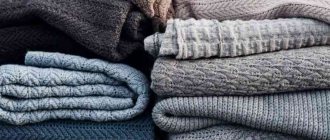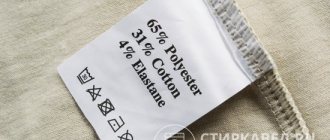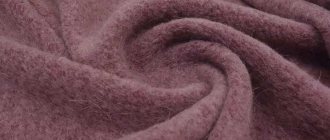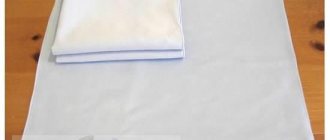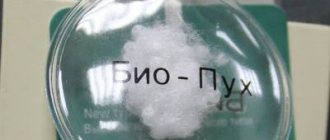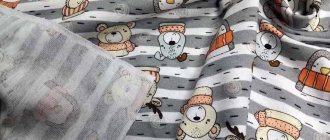Clothes made of wool help us get through the cold season because they are warm, cozy and at the same time practical. Washing delicate wool items in a washing machine may damage them. Therefore, many people spend a lot of time washing such items by hand.
But is it necessary to take such measures in order to preserve the appearance and main properties of your favorite clothes? We will tell you how to wash woolen items in a washing machine so that they retain their original appearance as much as possible and keep you warm for many more winters.
Features of wool products
There are several types of wool fibers and fabrics, which differ in the method of manufacture, origin, and the presence of synthetic impurities:
- Angora is a wool fabric made from goat or rabbit fluff. It is very pleasant to the body and is light and has low density.
- Camel wool is a 100% natural, environmentally friendly product. Its main properties are antibacterial, antistatic, light, hypoallergenic.
- Cashmere is a wool or wool blend fabric made from the down of cashmere mountain goats, synonymous with airiness, softness, and a symbol of prosperity.
- Sheep wool is a common type, known for its medicinal properties, and is considered one of the warmest.
- Merino – obtained from the wool of “fine-wool” Merino sheep. The yarn is smooth, silky, flexible, thermally insulating, and can also repel odors.
- Mohair is a fabric that partly consists of angora (about 80%), the remaining 20% is synthetic fibers. Mohair is less susceptible to deformation, is hypoallergenic and very durable.
Depending on the type, the properties and, consequently, the care requirements change. However, all types consist entirely or partially of natural hair, which, like human hair, is covered with tiny scales. Under the influence of water, temperatures and cleaning agents, these scales open, which makes the wool especially vulnerable. Left without protection, the pile sticks together, becomes compacted, deformed, and loses its airiness and softness. Therefore, it is important to carry out the process of washing a sweater, socks, hat or trousers made of wool as carefully as possible.
Recommendations
Washing wool products will be easy if you put the following tips into practice:
- During the washing and rinsing process, a sudden change in water temperature should not be allowed, since the woolen item may respond to it with deformation.
- When washing wool, you can use conditioner. It will make the item softer and help fluff up the threads and make the item softer.
During the drying process, you should pay attention so that the item does not stretch. If necessary, it should be slightly gathered with your palms, restoring its shape.- Most wool knitted items are not ironed, as such an operation can ruin the texture of the material. For some types of products, the ironing ban is strict. There should be information about this on the label.
- Any vigorous physical impact on the coat is prohibited.
- White woolen clothes are washed separately from the rest, even if the items do not fade. This is due to the fact that when processed together, colored fibers may stick to a white product, which will be difficult and time-consuming to remove, and without this, the appearance will be spoiled.
- Proper storage is one of the components of caring for things. Woolen clothing should be stored neatly folded. In this case, you need to take care of special moth repellents. During long-term storage, items must be periodically removed, ventilated and rearranged.
- You cannot soap the product itself or pour washing gel on it. Preliminary dilution of all drugs in water is mandatory.
Washing rules
Some people prefer to buy synthetic clothing because natural wool is quite difficult to care for.
There are several rules that will help you wash woolen items correctly:
- It is better to clean them as rarely as possible, because frequent exposure to detergents harms the fibers.
- Before washing, be sure to examine the sew-in tag. It indicates information about the acceptable mode, washing and ironing temperature.
- Some items can only be washed by hand, this is also stated in the instructions.
- To reduce damage to the product, it is better not to wash it, but to get rid of unpleasant odors by airing it in the fresh air.
- It is advisable to clean heavy stains before washing using a dry method.
What can harm a wool product?
- Frequent washing. Wool is not prone to easy soiling, absorbed odors are easily dissipated in the fresh air, and stains can be quickly removed with a brush.
REFERENCE! You can wash such things no more than twice a year, otherwise they will become deformed, lose their softness and fall off.
- Staying in water for a long time. Soaking in water for a long time causes the product to shrink or stretch. You need to quickly wash woolen items so that it takes no more than 45 minutes.
- When washing woolen items, sudden temperature changes should not be allowed.
- Drying not according to the rules, for example, in direct sunlight, on hot radiators, near heaters. Such actions may cause wool products to lose shape and color.
- Excessive loading of the washing machine. Wool absorbs water strongly, the products become heavy and can stretch and deform. Therefore, you can load no more than 2 kg of dry laundry into the machine at a time.
What can't you do?
Since woolen fabrics are delicate, there are precautions that will help protect them from damage. Here are some recommendations common to all clothing of this type:
- Wool does not tolerate hot water, boiling is also prohibited. In addition, you should not allow sudden changes in temperature during the washing process.
- It is not recommended to soak the material for a long time; the maximum allowable time is 30 minutes.
- You cannot twist, squeeze, stretch, or actively rinse the wool, since under the influence of external force it deforms very quickly.
- The spin speed in the washing machine should be set to the minimum.
- Washing with aggressive detergents is prohibited; low-quality powders and gels should also not be used.
- You cannot pour dry powder directly onto woolen fabric; before use, it must be dissolved in a large amount of water and whipped into foam.
- You cannot dry wool items hanging, that is, on ropes or hangers. Since the fabric does not tolerate high temperatures, it is not worth drying it on a radiator, with a hairdryer or other thermal influences.
- Whether ironing is allowed or not can be found out from the instructions on the label. Some types are tolerant of hot steam, while others may lose their shape and softness.
Water temperature
Wool should be washed at a temperature not exceeding 40°C; washing at 30°C is optimal. If you use hot water, the product loses strength, as a result of which it can shrink, become hard and unpleasant to the touch. Raising the temperature to 60-70°C is permissible only if you need to make a sweater a couple of sizes smaller, but you should do this as carefully as possible.
Detergents
Conventional washing powders are not suitable for materials made from natural wool fibers. It is recommended to use special ones for wool and silk, which prevent caking and do not destroy the structure. However, washing gels marked “For delicate fabrics” are considered more effective and gentle. They promote high-quality removal of contaminants and are washed out better without leaving streaks.
Unfortunately, no powder or gel will help maintain the softness of wool if the water in which the wash is carried out has an increased level of hardness. You can find out by observing how the liquid from the tap behaves when boiling. If scale remains on the walls of a saucepan or kettle, the water hardness is increased. In this case, it is recommended to use softeners and conditioners for washing, which will give clothes softness and freshness. For the same purpose, you can take a 9% vinegar solution. Acid is also suitable for preserving color: pour it into the conditioner compartment if the item needs to be washed in a washing machine, or use it when washing by hand.
Attention! If you urgently need to remove a stain, but you don’t have a suitable product at hand, you can use shampoo. It has a more gentle effect than conventional products.
Procedure
Woolen items should be washed in the correct order, strictly following the following procedure:
- Preparing for washing. Fasten all the buttons and clasps, if any, remove everything from the pockets, and turn the sweater inside out.
- Removing dirt with a brush. You can clean the wool with a small amount of glycerin heated in a water bath. It is worth considering that the bristle of the brush should be very soft and the friction very weak. Hydrogen peroxide, which should be moistened with a cotton pad, also removes stains well.
- Soak. This step is necessary if the dry method did not help, there are strong stains left that may not be washed off. You should not soak things for a long time, as staying in water destroys the structure of the fibers. You can leave them in the detergent solution for a maximum of an hour.
- Wash by hand or using an automatic machine. In the first case, it is easier to control the degree of damage, while the second method requires less time and effort. It is important to wash no more than 40-45 minutes.
- Drying. On a horizontal surface at room temperature.
- Ironing. According to the directions on the product label.
Coat type: what does it affect?
There are several types of wool. Each of them has its own characteristics. Knowing what kind of wool was used to create the item, you can select the optimal care for the products.
It is quite possible to wash camel, merino and alpaca wool with soapy water. After this, the item is washed in warm water, up to +35ºС.
Mohair, angora and llama wool should not be soaked or rubbed too hard . Contaminants from such materials are washed off with purified gasoline. Excess is blotted with a rag, and the item itself is washed in slightly cool water.
Sheep
This material is the most common and unpretentious in processing. It should be washed with water at temperatures up to +35ºС, without sudden cooling.
Both soap shavings and gels can be used as a detergent . Powders should not be used.
If soaking is required, it should not be longer than 10 minutes. Twisting is prohibited. The item should be rinsed very thoroughly.
camel
Things knitted from camel wool are light and soft. Washing is in many ways similar to processing items made from sheep yarn, but with some differences:
- water heating temperature – up to +30ºС;
- It is advisable to use less detergent than usual;
- Soaking is not long.
Cashmere
This type of wool is distinguished by its delicacy and low wear resistance. Processing such products requires great care:
- Hand wash at +30ºС.
- A small amount of detergent is used.
- Any force on the product is prohibited (friction, crushing, etc.).
Read about washing a cashmere coat here.
This video will show you how to wash cashmere:
Mohair
Lightweight and durable mohair thread is used both independently and as part of mixed fabrics and yarns. In this case, both synthetics and wool can serve as an addition. The washing method is similar to cashmere.
Vigogne
This type of wool is thin and very delicate. This is a subspecies of camel hair, but requires more careful handling:
- dry only in a horizontal position, as the material stretches easily;
- ironing possible;
- use of special washing gels;
- do not squeeze too hard;
- water heating – up to +40ºС.
Some items made from vigoni are prohibited from washing - they must be dry cleaned.
Alpaca
This type of wool is one of the most popular. Due to its subtlety, manual processing is recommended, in water with a temperature of no more than +30ºС .
It is advisable to use a special detergent containing o.
There is no need to soak alpaca - the material washes well even without pre-treatment. For rinsing, the water should be at the same temperature as for washing.
Angora
Angora is a delicate material, which in most cases the manufacturer prohibits washing. For such items, only dry cleaning may be acceptable.
If there is no washing prohibition on the label, the treatment should be as delicate as possible:
- Manually.
- No more than +30ºС.
- Virtually no detergent.
Doggystyle
Dog fur has healing properties and retains heat well. These items can be washed by soaking. Processing in a washing machine is allowed, but without spinning and in non-hot water.
Wool requires very careful processing, which is recommended taking into account the type of wool.
Features of washing in a washing machine
If you don’t have the time or opportunity to hand wash, for example, a wool blanket or sweater, a washing machine will help.
Before the washing procedure, you must do the following:
- Check pockets for forgotten small items: coins, pins, etc. They can ruin both clothes and equipment.
- Remove all removable accessories and cover non-removable ones with nail polish - this way the possibility of rust or other damage is minimized.
Nowadays, most models of equipment have a “For delicate items” mode, which helps to remove dirt as gently as possible: the drum makes the least number of revolutions, practically without damaging the sweater.
In the absence of these modes, wool should be washed in a washing machine using “Quick 30°” or “Hand Wash”, spin – minimum number of revolutions. It is better to add an additional rinse.
Detergents for wool products
If you do not have the desire or time to use folk remedies, then in the store you can purchase a ready-made product suitable specifically for wool.
- Gel for woolen items “Organics Wool” - suitable for machine and hand washing. It contains no phosphates, has protective and softening properties, removes odors and disinfects.
- Washing gel for black fabrics “Black Line Feinwaschmittel” is excellent for wool of dark shades and perfectly fights dirt and stains.
- Sonnet is an organic gel for washing wool and silk. The composition contains natural olive soap, which gives the wool elasticity and is gentle. Can be washed in a washing machine or by hand, hypoallergenic.
- Liquid "Denkmit Wollwaschlotion" - has a soft effect, smoothes fibers, restores the protective layer and structure of fabrics. The main thing is to follow the instructions for use.
- “Eared Nanny” conditioner for children's laundry (for woolen items with cashmere) - has a softening effect on clothes, eliminates static electricity, and can be used to prevent the appearance of pilling. Suitable for people prone to allergies, pregnant women and children.
- “Vanish Oxi Action” stain remover - contains active oxygen, which copes well with stains on woolen items, preserving their color. Suitable for both white and colored linen.
Proper drying
Since it is prohibited to dry products in a vertical position, it is necessary to place them on a horizontal surface, for example, on a table. Under a woolen item you need to place a fabric that absorbs moisture well, a terry towel will do. Products must be turned over every half hour to hour so that they dry evenly. Of course, this method requires some effort, but it will help maintain shape. Drying can be done outdoors, but it is better to avoid direct sunlight.
Standard
Manufacturers of units offer a fairly large number of standard washing modes.
Synthetics (mixed fabrics)
The “synthetics” program is designed for fabrics such as lavsan, viscose, polyester and other synthetic materials. Cycle duration is up to 1 hour 50 minutes. Spin speed up to 800 per minute. Maximum heating temperature – +60.
The program is also suitable for items made from mixed fabrics, i.e. containing a certain percentage of threads of natural origin.
Delicate (manual)
“Delicate wash” is set if you need to tidy up fabrics such as silk, voile, cambric and others. During this cycle, the water is heated only to +40. There is no rotation of the drum: it simply sways from side to side. Spin occurs at minimum speed or is absent altogether.
Cotton
“Cotton” is a program that can be found in the SMA of any manufacturer. Traditionally used for bedding sets. Since the fabric is characterized by increased strength, the water can warm up in the range of +40…+95°C. The latter allows you to boil things.
Drum revolutions during spinning are over 1 thousand. The cycle duration is up to two hours.
Washing time in the “Cotton” mode at +40 degrees takes much less time. This cycle is intended for colored fabrics. Otherwise they may shed.
Fast
Used in all models. The “quick wash” function is suitable for lightly soiled items. Duration – 15...60 minutes. Depends on the manufacturer of the unit.
Preliminary
“Preliminary” washing takes place in two stages and is intended for heavily soiled items. In this case, the detergent is placed in both compartments of the cuvette. The first part of the cycle takes place at a lower temperature than the second. Designed for primary tissue cleansing, and the second one is the main one. During this process, the water warms up more strongly, which allows you to remove remaining contaminants.
Fact! The pre-wash mode consumes a lot of water and electricity.
Intensive
An "intensive" wash takes two to four hours and is designed for very durable fabrics. Includes mandatory soaking or pre-washing. Uses all unit resources.
How to bleach a woolen item?
Everything white eventually becomes dull, yellowish or grayish. However, if the whiteness of ordinary picky material is restored using boiling and soaking with bleach, then such methods are not suitable for delicate ones.
Here are a few methods to help whiten wool:
- Baking soda and ammonia work well with old yellowness. 1 tbsp. l. It is necessary to dilute it in 5 liters of cool water, add 2-3 drops of ammonia, soak the product in the resulting liquid for 30 minutes, wash it in an automatic machine or by hand.
- Hydrogen peroxide will help bleach white woolen items. It needs to be added to water (1:8), then soak the clothes in this solution for an hour.
- Dissolve about 500 g of salt in 5 liters of water, leave the wool for half an hour, then wash with conditioner.
Frequent or rare washing: what to choose?
Frequent washing is undesirable for wool. If the item is not dirty, it can be dry cleaned, which allows you to maintain the shape and texture of the item. This can be done with a soft clothes brush.
Another technique to extend the life of warm clothes is ventilation. Wool easily absorbs odors, but they also disappear easily. To do this, you can hang things outdoors.
The frequency of washing an item directly depends on the intensity of wear. If worn rarely, such a thing can go without washing for several months. But if the product is sweaty or very dirty, you cannot do without high-quality washing.
Even delicate washing contributes to wear and tear of the material, loss of softness and deterioration of shape.
Tips for care and use
It is very important to properly care for woolen items so that they last as long as possible. Here are some recommendations:
- A woolen item that has shrunk after washing should be slightly wetted, ironed through gauze at a low temperature, smoothing it, and given the desired shape.
- You should not try to pull out the pills from a sweater with your hands, much less cut them off with scissors. There are scallops and electric machines for this.
- You should not overuse dry cleaning, even if dirt can only be removed with its help. The substances used in the cleaning process gradually corrode and thin the fibers.
- The ties can be removed using a crochet hook: with the tool you need to pick up the loop that has come out from the inside and carefully pull it back.
- Woolen clothes should be stored on a shelf or in a drawer; they may become deformed on hangers.
- Moisture is the enemy of wool, so you need to avoid damp areas when choosing a storage location.
How to wash by hand, at what degrees?
Most often, hand washing is used to care for woolen clothing. With this treatment, the item is washed delicately, without intense mechanical impact.
Procedure:
- Prepare a woolen item. If it has pockets, they need to be emptied.
Turn the product inside out.- In a large basin, dilute detergent in warm water (30ºС).
- Wet the product by completely immersing it in water.
- Washing is carried out by lightly squeezing and turning the item, paying attention to those areas that were most dirty. You can't rub the thing.
- After washing, the water is drained and clean water is collected for rinsing.
- You should rinse things several times, replacing the water.
- Wring out the woolen item through a terry towel.
What does a full cycle consist of?
The sequential execution of the usual stages - washing, rinsing and wringing out things - constitutes a full cycle of operation of the machine. The device allows you to regulate the specifics of these operations.
Wash
The choice of washing mode is determined by the following parameters:
- fabric structure;
- the presence of decorative elements on products;
- contamination (you can include soaking, boiling cotton fabrics).
The right choice will determine not only how well things are washed, but also possible damage to the laundry from the aggressive effects of temperature and high speeds.
Rinsing
When rinsing, detergents are washed out of fabrics. Many people prefer to run an additional rinse mode to thoroughly wash the laundry from powder.
Rules for caring for the device
The machine will last a long time and without problems if you care for it properly:
- install on a perfectly flat horizontal surface - this will eliminate vibration and wear;
- ensure water connection with the required pressure, install the drain hose correctly;
- avoid overloading during washing;
- do not clog the drum and drain hoses with debris or small objects;
- wash items with metal parts in bags;
- use machine detergents.
Between washes, you need to let the machine rest for several hours to prevent overheating and rapid aging.
What preventive maintenance work is required:
- Ensure the safety of the rubber seals, avoid compression and tearing, and wash with a soft sponge.
- Do not use aggressive agents for cleaning the outside and inside, which can damage plastic and rubber.
- Clean powder containers and wash out any remaining detergents.
- After finishing washing, leave the hatch open so that the parts dry in the air and odors and dampness do not accumulate in the body.
- Do not store dirty laundry in the washing machine.
- Regularly clean the casing of debris by removing the bottom panel.
- Check the condition of the water and drain hoses for damage or disconnection.
- You can improve the quality of water coming from your tap water by installing a filter.
- Do not use folk descalers to clean the machine, but only those recommended by the manufacturer (Calgon).
- If there are problems with the water in the tap - low pressure, dirty, sandy or rusty - it is better to postpone the washing or stop it (“Pause”) if it has already started.
Once a year, the machine without laundry is run at high temperatures with powder and cleaner to descale the drum and clean the filter.
An automatic machine is an ideal assistant for washing. Any housewife can master its use. You need to carefully study the instructions and control panel in order to take advantage of all the capabilities of this convenient household appliance. Knowledge of all modes, the ability to set the most effective and necessary washing program will save time and help reduce water and energy costs.
Share link:
Additional
In addition to the main programs, manufacturers can use additional ones. There are quite a lot of them.
Wool
Not all units are equipped with the “Wool” mode. The cycle is intended for the care of knitted and knitted items. The water warms up to a maximum of +40. There is no rotation of the drum - it simply sways from side to side, simulating working with your hands. When spinning, the minimum speed is automatically used.
Fact! In order not to provoke overload, it is recommended to fill the drum only 2/3 of the total volume.
Sport
The program includes soaking or pre-washing. This ensures maximum cleaning of difficult fabrics such as those used in sportswear.
Shoes
Designed for the care of sneakers and sneakers made from textile fabrics. Cycle duration is up to 50 minutes.
Kids' things
Washing occurs at high temperatures, additional rinsing is provided. Suitable for allergy sufferers, as detergents are washed out as thoroughly as possible.
Night
The quietest program, so you can use it at night. There is no spin and no sound signals.
Volumetric things
Designed taking into account the characteristics of outerwear and other wardrobe items that can absorb large amounts of water. The average cycle duration is 1.5 hours. Suitable for soft toys.
Hypoallergenic
The cycle uses one additional rinse to ensure that the detergent particles are completely washed out of the fabric. The water heats up to +60, so washing delicate fabrics is prohibited.
The mode is quite long and uneconomical, since heating requires more electricity. Water consumption also increases.
Partial loading
The process is shortened in time, but retains the main stages.
Easy ironing
There is no intermediate spin, and the final spin occurs at lower speeds. Rinsing uses a larger volume of water.
Before the end of the cycle, items are steamed, which makes ironing difficult fabrics, such as linen, easier.
Fact! It is recommended to fill the drum to approximately 2/3 of the permissible weight.
What water should I wash in?
To wash wool, you need to select the optimal temperature. Both hot and cold water can damage fibers. In this regard, it is recommended to wash sweaters, scarves and jackets at a temperature of 30–35˚C. This condition must be met for both hand and machine washing.
You should rinse things in water at the same temperature. It is allowed to gradually reduce the temperature with each water change. It is strictly forbidden to send products from warm water to ice water. This will destroy the fibers and may cause things to become deformed.
Economical
SMA manufacturers also offer economy cycles. They are so called because they help reduce the use of either or a resource.
Author:
Anastasia Kukushkina
I hope you enjoy the article I have prepared for you! If you find errors in it, write to me about it! I will answer any questions you have, ask them!
